Carla Stalling Huntington Walter's Blog
October 5, 2025
Managing Cultural Conditioning
Learning about cultural conditioning that keeps some of us “stuck” in habitual ways of thinking and acting. Dance Dharma and Zazen can aid in letting go of old systems that perpetuate racism and bigotry, as well as give a more wholesome approach to identity.
You can also check out these authors who are offering help in these days of constant change.
October 2, 2025
What is Dance Meditation?
The author of Dance Meditation and Zen for the Black Cancer Patient shares insights and reads from her book.
September 18, 2025
The Zen Dancer
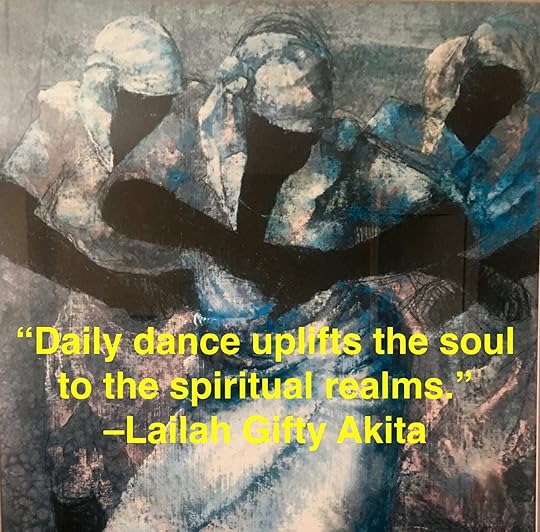
The other day I’m driving along and somebody pulled out in front of me so I had to slow down. “Why couldn’t you wait for me to pass?” I thought. For a few weeks now, a water pipe has been spewing water into the street near my home and the city is none too fast to get after it. The mail people don’t deliver the mail on a regular schedule. It’s too cold in here, why don’t they make the room a little warmer? Okay, now that’s an insult to my intelligence! That thing I bought is a piece of junk, a rip off, and no, I can’t get my money back.
So many situations can make me angry. How people act, what they do or don’t do, what I don’t get, how I was treated. What’s not fair. This is mine, it’s not my fault. Perceived or imagined discrimination. Double standards.
My culture has taught me and many of us to be justified in anger too.
Where does anger come from? Fear maybe. Attacks on identity? Putting my importance above all? Ignorance? And more to the question, what does indulging in anger do for us?
First of all, indulging in anger keeps me from self reflection, and seeing the world as it is, or holding on to fixed views. Encouraging bitterness and self-righteous indignation.
Secondly, repeated indulgence in anger causes chronic stress, and as I already noted in a previous post and podcasts chronic stress is a contributor to cancer and other health related issues. Some have argued that justified anger arises from the need for recognition, and its “... complex interplay between anger, [and] self-esteem….” .Sometimes indulgence makes us feel good. Get self-righteous.
Third, and to that second point, anger is addictive and like other addictions, releases dopamine, and it makes you feel good. And we have been told that “Anger is a public epidemic in America.”
So, Let’s talk about Two Sides of an Unexamined Relationship with Anger
Some of us have a committed, long term, sometimes a generational relationship with anger. It’s the way our families and cultures have existed, for eons, centuries, decades. A lot of times we have only been able to get what we wanted, or be made whole through using anger. We “act a fool” so that we can get what was withheld. We turn our anger into hate when events can’t be explained to us, like when we get ripped off from scams, when the people we marry turn out to be different than what was portrayed, when gangs or groups force violence, when the doctors make mistakes. We gaze outward, rather than inward.
You have your own lists–justified maybe–of these kinds of situations I’m sure.
But sometimes, anger supports positive change too, acting as a motivator when channeled in wholesomely intentional directions. It helps us take action, and our actions interact with the energy of the universe to shift us, and those we encounter. As long as we’re aware of what anger is doing, how we harness it, and how we express it, we can see it as skillful, in line with the Silence.
It’s when we let anger run rampant with no connection to our true Selves that we get into binds.To slow it down, we can remember the Ninth Bodhisattva Precept to steer us from “anger driving us and our community,” to, instead, “us driving anger.” In particular, this precept encourages us not to indulge in anger, helps us realize the Silence that’s behind everything as well as to recognize beneficial actions in situations. Why? Because oftentimes, indulging in anger, or encouraging others to, leads us to act in ways that produce unintended outcomes, setting into motion events and consequences that may not be so good: For us and everyone else, for years, if not generations and lifetimes, to come.
Letting go of ego, or recognizing ego is also crucial to uncovering–recognizing– indulgence in anger. Ego sometimes masks the fact of life and death, which is each instant of our feeling unrecognized, and trying to concretize impermanence. Each episode of anger indulgence is sparked by self, by a desire of some kind. Yet if we slow down, sometimes within the anger reaction, there’s a message being delivered to us through a moment in time and space by what is being presented to us. Behind it is Silence if we can get close to it. According to Dainin Katagiri and other masters, Silence is Buddha-nature, or Suchness, or Emptiness. Touching the Silence even when the ego is inflamed is to touch emptiness–to know impermanence. To release fear, to capture where we are relative to time and space, to be okay with not understanding why things are the way they are. Not needing recognition. Facing life and death.
Part II Silence of Dance MeditationBeing in the present moment and realizing there’s nothing between you and Buddha Nature, or the Silence, makes this awareness real. In dancing we are also touching the Silence. Realizing there’s nothing to get angry about is the key, but not in a “stuff your feelings, denial” kind of way. Not accepting the unacceptable, not being a doormat. It’s a realization that there is something in the Universe, a Radiant Light that threads through all sentient beings. We can realize this Silence in many ways, remember it, and bring it into the present moment when dealing with life’s situations. With dance as meditation, we touch Buddha Dharma, Buddha Nature, and create Dance Dharma.
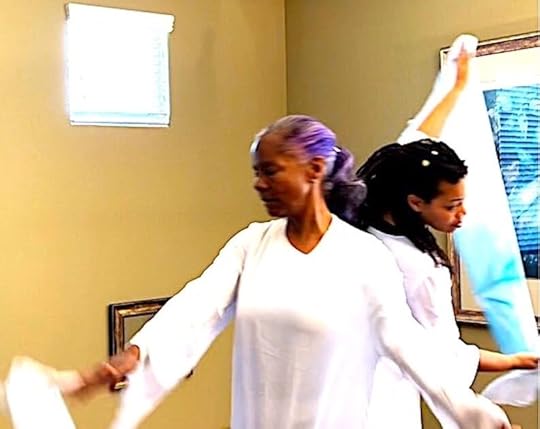 Carla Stalling Walter and Choreographer and Dancer Cherie Hill, photo courtesy the author. Copyrighted.
Carla Stalling Walter and Choreographer and Dancer Cherie Hill, photo courtesy the author. Copyrighted. This means there is no space where the ego can get in and we can see ourselves and others in a more compassionate light. If we dance together we have prediscursive awareness. In dance meditation we embrace and connect with the human reality of life and death and create something in the moment, usually beautiful, artistic, and fully engaging the body and mind. There’s no gap, nothing is left behind.
Touching the Bottom of Our Lives
As I was reading Returning to Silence by Dainin Katagiri, who was a noted Zen Master and teacher from Japan, I was hit over the head with his use of dance and ballet in describing Buddha Dharma. He says Chinese people of ancient times expressed spiritual joyfulness naturally through dance. He encourages us by saying “When our activity comes from the bottom of our life, it’s dancing.” Every movement is a dance, in other words.
He writes, “Even though we don’t understand a person who creates a wonderful dance that comes from the basic source of energy and not just from [an] intellectual sense, still great dancers always create like this … “ Dancers–you and I– are touching “the manifestation of the basic source of energy or right entrance; this is the … practice of human life that is connected to the problem of life and death. Through this you can understand what human life really is.”
Continuing, he says that dance movements are both independent and connected, with no gap between dancer, the dance, others dancing, nor the audience, presenting it all with wholeheartedness, perfect beauty and impermanence happening in the same moment. He concludes that having “faith is exactly to live like this.”
In letting go of “I” when we dance in every day activity, all we have to do is just move our body and the mind will come along, and the space accommodates.
When dancing, we forget about living and dying.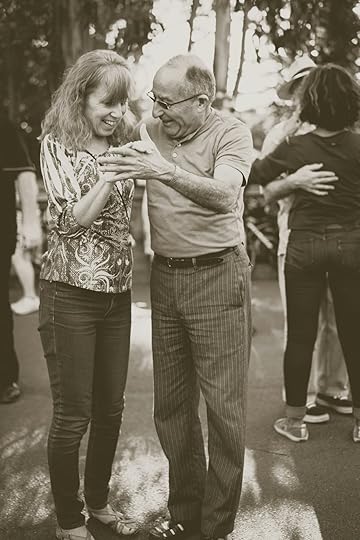 Photo by John Moeses Bauan on Unsplash
Photo by John Moeses Bauan on UnsplashOkay sure, if we’re in a social situation with dance, sometimes we judge “they can’t dance” or “I have two left feet,” or whatever. But really, in each moment we are just being, there is no place for judgment or indulged anger which clouds our vision. If we have an object in mind, right in the middle of dancing, or just doing, it interrupts, distracts. Anger indulged in is a mental projection reified, an obstruction to a flow of joy. We have to let it go or harness it for beneficial action.
This letting go is how we practice. If we think of “I” as the dancer, others, or the audience as the observers, we have subject and object. Like when we think “life versus death.” But with discipline, we dance through peace and harmony with the music, audience, and other dancers. We dance, remain in emptiness, dance, remain in emptiness. Katagiri explains, “This is the beauty of dance. We can’t know what the beauty is, but we can see it. …. When we dance, we cannot look at the dance, the stage [or dance space], as something separate from us. We must be right in the middle of dancing. We are one with the dance and are realizing the significance of the dance, allowing us to have dynamic identity action… something electric—like sparks flying—happens between you and others. This is spiritual communion, the true meaning of Emptiness.”
Dance Meditation and Cancer
Engaging in dance meditation with cancer treatment has been shown to aid with healing and emotional stability. Helping to embrace living and dying. Helping loved ones and caregivers do the same. But even before a cancer diagnosis, and within remission, dance meditation also reduces indulgence in anger as we live in the here and now. As I said, anger is a contributor to chronic stress, which is a contributor to cancer genesis. I would rather that you dance and give up on anger indulgence altogether. Touch the Silence and know the value of your precious life.
Please visit and follow… my
August 27, 2025
Skillful Ways, Skillful Means
July 30, 2025
Skillful Ways, Skillful Means
About two years ago I was diagnosed with the blood cancer multiple myeloma (MM). At the moment no one knows what causes it, nor how long you’ll be able to live a quality life should you be diagnosed, and receive timely and adequate treatment. There’s no cure. I was diagnosed when it was at an advanced stage. Today, I am on maintenance medications, with no trace of the cancer detectable in my blood. That’s really cool. And I’m truly grateful.
Part of my recovery came from learning about the disease, and alternative approaches to overcoming the cancer, along with the standard infusion and chemo therapies. I discovered MM impacts American Black people like me who get the disease more often, and we get the worst treatment with the poorest outcomes. That also holds true for other cancers as well. In this article in PART I, I’m going to talk a tiny bit about history but quickly move on to PART II and discuss ways that will be beneficial for American Blacks and others who might face this situation. To be clear, I’m not a medical professional. What I have to say here is based on my experience and meant to show how to change mindsets in order to help live a quality of life through Buddhist practices.
Thanks for reading Dance and Zen Meditation! Subscribe for free to receive new posts and support my work.
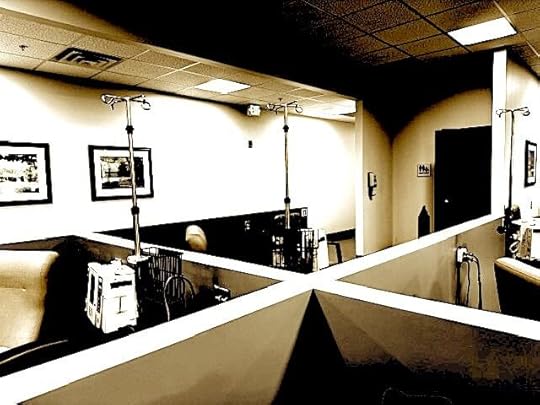 Cancer Infusion Center, photo courtesy Carla Stalling Walter
Cancer Infusion Center, photo courtesy Carla Stalling WalterI’m suggesting here that we can utilize the Buddhist Noble Eightfold Path before and after diagnoses to help us through the entwined histories and consequences we find in our lives today.
The Noble Eightfold Path includes:
right view - drawing from the Four Noble Truths in understanding the nature of suffering
right thinking - creating wholesome intentions and points of view
right speech - speaking kindly, being honest, from a place of loving kindness
right action - engaging in ethical and non-harmful actions
right livelihood - being in a job or profession that doesn’t harm anyone
right effort - making a conscious effort to remove unwholesome thoughts, words, and actions
right mindfulness - taking time to understand our lives as they are
right concentration and meditation - keeping on the path so that your mind can be clear and calm
As you can imagine, each of these views can apply to multiple circumstances simultaneously. So first I’ll give a brief overview of how the impact of unavailable medical care has hurt certain people and then I’ll weave in five skillful actions we can take, that I have taken and continue to, that rely on the Noble Eightfold Path to provide a kind of added ancillary but critical medicine. My hope here is to help reflect upon ways to bring agency to health care with our bodies and minds. You might apply them in your own way or see more than one way. There are of course no guarantees of any outcome due to impermanence, yet we can take responsibility for our health by following simple steps to develop, follow, or stay on a path.
PART I
American Blacks and Cancer
In 2022, about 224,000 people died from cancer and about a third of them were American Black people. According to the American Cancer Society1 we have the highest mortality and the lowest survival rates when it comes to cancer. And for sure, the rate of MM diagnoses is on the rise for our population. Multiple myeloma occurs twice as often for us, and comprises 20% of all myeloma cases. Being overrepresented here means that the onset exceeds the percentage of American Blacks in the US population by about seven percent. We’re contracting the disease at younger ages on average, experiencing disparities in care, including delays in diagnosis and limited availability of cutting-edge treatments. American Blacks have more cancers and have greater barriers to cancer prevention, detection, treatment, and survival, due to policy issues and lack of health insurance, resulting from historical and current antiblack racism. American Black people have the highest death rate and shortest survival of any racial/ethnic group for most cancers in the US. American Blacks and people of color are many more times as likely than whites to get the disease and die more frequently.2
Why is this? Let’s Recall a Bit of History
Some folks in the medical system believe we’re inferior so we get worse care.3 Historically, American Blacks, people of color, and those that are poverty stricken have often received less than the best, or timely, medical treatments if any. That’s still going on these days too, through laws and policies that allocate resources in ways that harm members of certain groups.4 American Black women, men, and children are the most negatively impacted and those in LGBTQIAP+ groups even more so.
What are the health care systems that rely on policies and laws in administering care? Hospitals, emergency rooms, urgent care, nursing homes, addiction recovery centers, doctors’ offices, skilled nursing facilities or rehabilitation centers, physical and mental therapy clinics, cancer centers, infirmaries, surgical centers, and so on.
Unfortunately good medical care and medicines in the US are generally only available for those with adequate health insurance or with enough money, or with “friends and family who are doctors they can call,” or who can pay the price. Sure, certain organizations provide support for some of the costs of treatment, such as grants or pharmaceutical set-asides, or children’s hospitals. You have to apply for these. However, adequate health insurance that just provides it without having to jump through application hoops, includes coverage for not only chronic and acute illnesses like cancers, but also includes annual wellness evaluations, prevention, education, addiction treatment and mental health attention, for everyone on one’s insurance.
 Photo by Ozkan Guner on Unsplash
Photo by Ozkan Guner on UnsplashWe have to Change Views
One problem: a lot of people, especially American Blacks, don’t trust the medical or pharmaceutical industries. This stems from historic mistreatment, neglect, denial of American Blacks’ entrance to medical or nursing schools, and perceptions of inferiority created by and residing in a psyche of people suffering from antiblack racism. While these causes and conditions and collective karmic scars aren’t to be forgotten or ignored, it’s important to work with seeing our mindsets, our egos and unskillful thoughts, that may prevent us from getting the care, or giving it, that’s available. Many people in healthcare from various backgrounds, including my MM oncologist, general practice physicians, and other medical professionals, are aware of this history and reality and work against it, work to eliminate it and bring equity to it. But we must take the skillful path and apply the right effort to seek them out, avail ourselves of what they offer, to get the help we need. This could be considered a “right view.”
Along with getting the valuable medical support we need, some other “right actions” should be considered. These apply across all ethnic and social groups. Namely, how do we live before a cancer diagnosis? There’re several actions we can take to try to lessen the likelihood of getting sick, reduce suffering, and carry these forward into and beyond a cancer diagnosis (or other life limiting diagnoses) and treatment. A short list includes reducing negative chronic stress, embodying compassion, using mantras, meditating and dancing, and finding moderation in consuming. Many others can be added in concert with those, such as exercise, engaging with fulfilling social interactions, gaining feelings of belonging, laughter and play. Those are good topics for another article.
Five Ways of Supporting Your Health with the Noble Eightfold Path
1. Limiting or reducing chronic stress, the stress that arises from “reasons like adversity, depression, anxiety, or loneliness/social isolation can endanger human health.” Chronic stress is stress that is ongoing and hurts the body and mind. That stress is a very big deal in cancer, and there’s evidence of it being linked to some types of cancers. “Recent studies have shown that chronic stress can induce tumorigenesis and promote cancer development….”5
Many American Blacks and other people of color face over the top chronic stress during their childhoods and on through their lifetimes. It’s really important to address the fact that chronic stress can make life more difficult, can put you in unhealthy mental states which no one needs but particularly not after a cancer diagnosis. Chronic stress management is very critical in being proactive with your health.
Work is a stress producer, no doubt. The society we live in valorizes hard work for rewards, yet we know that in many cases, it’s a myth especially for American Blacks, people of color, and some in poverty. Finding “right livelihood” and time for rest and sleep within each day can support your wellbeing, and doing so can lower the risk of many diseases, including cancer.
Take short breaks during the day to let your mind and body rest. During those periods, be still and silent if you can and refrain from talking or thinking about your problems. Try to set up a sleep schedule so you go to bed and get up around the same time each day. Prepare your sleeping area so you can have peace and quiet. Stop using devices at least an hour or more before you lay down to sleep. Thich Nhat Hanh6 advised that we turn off all media all the time, stop watching violent and sexually abusive programs, and reduce our talking topics to those which are wholesome. Read up on why getting enough rest and sleep are important.
Yes, it’s true that we may feel we can’t stop working too much because “we got bills,” or fear of losing the job we have. How do we rest and sleep when this is the case? The answers will be different for everyone, however, they require changing thinking, letting go of certain cultural beliefs, setting healthy boundaries, and reevaluating needs and priorities. These open us to a different awareness, and are examples of taking “right action.”
2. If you can, hold the focus of being compassionate with yourself and others as a perfect gratitude and “right thinking.” Be grateful for calmness that comes from managing stress, and getting enough rest and sleep. Celebrate any good news you receive or tiny wins you have (like, I took a five minute break today, or I tried something different today). Focus on developing and offering a soft heart, kindness, and generosity especially when you feel agitated. I’m not saying ignore feelings or what not; appropriate responses are needed and important. I’m saying tune into the habit of holding compassion for yourself and others.
3. When you find your mind drifting to fear of the future or thinking of negative thoughts of the past, focus on a mantra. This could be a type of “right mindfulness.” This shift of focus can take some practice, since the mind likes to travel down well worn familiar, making us feel bad sometimes, paths! Take some time to get a few mantras memorized. They don’t have to be long, just a few words. Some people call them affirmations, but whatever you call them, get in a new habit: when those negative thoughts arise, be aware of them, and then shift to your mantra. At first it’s not easy but soon with practice you’ll find the mind is staying present, which is a great way to reduce stress. A list of mantras can be found here; if these don’t serve, write your own!
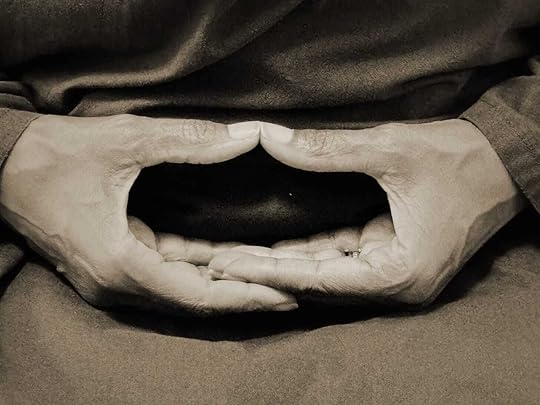 Cosmic Mudra, photo courtesy Carla Stalling Walter
Cosmic Mudra, photo courtesy Carla Stalling Walter
4. Practicing Zazen and Dance Dharma are important to get the body moving and the mind engaged with it in the here and now, to be in “right meditation.” Zazen is sitting quietly, focusing on your inhale and exhale, not trying to get, do, or be anything. Sit with your eyes open, facing a blank wall, in the crosslegged position or in a chair or lying down, back straight, and hands in the Cosmic Mudra for a time.
You can start out slowly with a few minutes and then increase as you feel comfortable. Set up a daily schedule preferably before leaving the house to start your day. When Zazen has concluded, remain present and attentive as you connect movement to your daily activities.
Dance Dharma comes in many forms such as sacred dance or kinhin and allows you to continue to maintain the space which helps to connect you to Buddha Nature, and stay present. For example, if you reach for a glass of water, or brush your teeth, remember that you're dancing, present, and moving in space and time. Feel the space that you move in, and even though you might not see it, may not understand time, just acknowledge they’re there. Like the space between your eyes and this that you are reading. Do you see it? Mostly we just look through it, not acknowledging its being. But it’s definitely there, right? Do you see the space? Do you feel it on your eyeballs? Your skin?
5. Find moderation in eating foods that are prepared well, at home if possible. I know this can be a challenge for some! Yes, it may “take a minute” before you’re fully able (willing?) to prepare food at home, take your food for lunch or dinner if you’re not going to be home, depending on your situation. But it’s worth the time to get to that point. You might get a plan and set some boundaries. Yes, people may laugh at you, even accuse you in so many ways of betraying them. They feel loved when you eat their food or eat like they do! Just let that go. Get a few cookbooks or recipes. There are plenty available online or at the library. Try out different ways of preparing foods. You won’t like everything but that’s okay. Make enough for lunch the next day. This will take “right effort” for sure.
Reduce and try to eliminate eating ultra processed and packaged foods, as well as eating fast food. The hamburger isn’t giving you a break and that other one don’t “got the meat” you need! Anyway, these and other fast foods are generally loaded with extra salt, flour, bad fat, sugar and preservatives. Taken together, these can be addictive. In many cases ultra processed, packaged, and fast foods cause chronic inflammation which is a stress trigger for the body. Eating them can cause heart disease, cancer, type two diabetes, obesity, and digestive problems. Focus on getting enough low cholesterol proteins, and high protein plant based foods, enough fiber, such as whole or sprouted grains, beans, fruits and vegetables. Reduce eating beef, white bread, and foods that cause chronic inflammation which are associated with cancer and other debilitating illnesses.
As you eat, remember that you are moving, dancing the move, not just taking the process for granted. Where does the food come from? How did it get to you? What about the waste that you accumulate from eating? Where does it go? Do you remember the empty space you’re consuming in? Slow down and focus on breathing and breath, engaging your calm mind. But when you do eat, just eat. Put away the devices and just eat. It’s a bonus if others who are practicing better eating are present, either physically in the room, or virtually. And remember to hydrate: avoid all sodas, energy drinks, and intoxicants. Water, healthy juices, certain teas, these are all very good for the body and mind.
We can definitely use right speech in each of these five areas to voice what we need in loving and compassionate ways, to ourselves and others. We can use our hearts to inform our speech so we remember that everyone is suffering in some form or another. Being kind and gentle with our circumstances, saying encouraging words to ourselves and others, with no expectations, these are ways to give priceless gifts.
Following One Continuous Path
Even though at present people don’t know what causes MM, and we have historical and current policies in health care that are often less than optimal, in some aspects dismal, we also have ways of being and thinking that can address our individual and collective outcomes. This rings true regardless of who you are. Applying the Noble Eightfold Path as we remember the Four Noble Truths in our daily lives, and taking a few small daily incremental steps to change our mindsets, practicing Zazen and Dance Dharma, provide approaches that reduce suffering, for ourselves and others. I have found them to be very supportive in my understanding of and approach to living a quality of life in this world with MM.
Carla Stalling Walter, PhD, MBA, Author
Dance Meditation and Zen for the Black Cancer Patient , 2025
Sacred Dance Meditations: 365 Globally Inspired Movement Practices Enhancing Awakening, Clarity, and Connection , 2020
1American Cancer Society, Cancer Facts & Figures for African Americans 2019-2021, Atlanta, American Cancer Society.
2Kanapuru, Bindu. Analysis of racial and ethnic disparities in multiple myeloma US FDA drug approval trials. Blood Adv. Mar 22; 6(6): 1684–169, 2022. doi: 10.1182/bloodadvances.2021005482
3Geiger, H. Jack. Racial and Ethnic Disparities in Diagnosis and Treatment: A Review of the Evidence and a Consideration of Causes. Unequal Treatment: Confronting Racial and Ethnic Disparities in Health Care, edited by B.D. Smedley, A.Y. Stith, and A.R. Nelson, Institute of Medicine (US) Committee on Understanding and Eliminating Racial and Ethnic Disparities in Health Care, National Academies Press, 2003. www.ncbi.nlm.nih.gov/books/NBK220337/;
Derman, B.A., et al. Racial Differences in Treatment and Outcomes in Multiple Myeloma: A Multiple Myeloma Research Foundation Analysis, Blood Cancer Journal, vol. 10, no. 80, 2020, doi.org/10.1038/s41408-020-00347-6.;
Cho Beomyoung, et al. Evaluation of Racial/Ethnic Differences in Treatment and Mortality among Women with Triple-Negative Breast Cancer, JAMA Oncology, vol. 7, no. 7, 2021 pp. 1016–1023. doi:10.1001/jamaoncol.2021.1254.
4Yearby, Ruqaiijah, et al. Structural Racism In Historical And Modern US Health Care Policy, HEALTH AFFAIRS VOL. 41, NO. 2: RACISM & HEALTH February 2022 https://doi.org/10.1377/hlthaff.2021....
5Dai, S., et al. Chronic Stress Promotes Cancer Development. Frontiers in Oncology, 10, 1492, 2020. https://doi.org/10.3389/fonc.2020.01492
6Hanh, Thich Nhat. Anger: Wisdom for Cooling the Flames, Riverhead Books, 2002
April 28, 2025
Dancing Three Natures
Getting Too Dizzy Lately?
Sometimes I lose my focus on what my life is about. And it seems as though there are lots of opportunities to shift my focus, taking my mind down twisted dizzying paths and conjuring up stuff that’s not actually there. Or making me feel anxious, afraid, and maybe resolute.
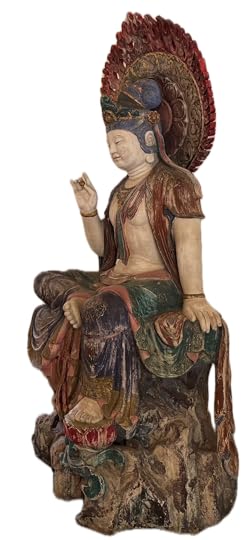 Avalokiteśvara - San Francisco Zen Center, photo courtesy of the author
Avalokiteśvara - San Francisco Zen Center, photo courtesy of the authorSo what are we focusing on? Contemplating? The projected thoughts of “what if?” Or the memories of “what isn’t?” Or the internal scream of, “This isn’t what I thought it would be! This isn’t how it’s supposed to be!”?
Spinning Around Endlessly
Recently I had experiences where I imagined it was going to be a certain way, providing certain lovely outcomes. I was seriously ready to have my projections materialize right now. I’d been thinking about them and living with them for months.
One was a talk I was going to give: My session proposal had been accepted! And I remembered the way the event was organized last time. The place was packed, over 150 attendees, and one of the keynote speakers was African American. There were plenty of concurrent sessions, even though there were only a couple of African Americans in attendance. I was thinking that maybe this event would be a point in time when I would finally be recognized for my contributions. ‘Yay!!’ I felt all inside. I’ll be famous! As it turned out, the event was organized differently than last time. In order for participants to attend my concurrent session, they had to drive 30 minutes away from the main event space! And only one other session was being held where my was, and it was also offered by an African American. So guess what? There were three people in attendance at the sessions. No, they weren’t African American. Ugh. Not that I wanted particular people there. I just wanted some people, not three.
And another experience was an opportunity I was both hot and cold on, after having been invited to put my name into a hat. You know, the one your ego is telling you to go for, and at the same time your gut is saying ‘are you insane? Don’t you remember what happened last time?’ My response: ‘Well, maybe this time it'll be different!’ As it turned out, the organization’s dysfunction showed up real quick, slapping me upside the head, to see it as it is. That helped me remember what it was like last time. Luckily, the invitation didn’t bear fruit, as the role was “put on hold for budget reasons.”
These two situations just disappeared, just as they had arisen. I was very disappointed at my chasing clouds in the sky, and once again being distracted from my focus by my external seeking for affirmation, fame, and fortune “out there.”
Family and Friends: Estranged… Transitioned…
At the same time, people in my life, defined culturally as “my peeps,” weren’t supportive at all. They have very rarely asked me (okay never) “How are you? What’s happening with you?” Some are ghosting, others are gaslighting, and still others are non responsive or communicative, unless they want something. Why do I have these kinds of family in my life? Karma? They’ve been with me for years, in different forms. Attempts to build some kind of healthy relationship with each of them, well, wasn’t working, hadn’t worked. I’ve discovered a deep letting go, a “not wanting” anything from any of them, “not taking what’s not given” from them. And seeing them, compassionately with wisdom just as they are. After doing a little reading and research, I found that there are millions of people in similar situations–estranged–with family, and its prevalence can differ when based on gender and ethnicity. Most black folks won’t talk about it, and they won’t confess it on a survey either.
Then a friend transitioned suddenly at the end of last year their family was filled with grief. They spewed blame onto the deceased for having transitioned due to poor choices, but no one took blame individually. “I tried to tell him,” they said. They expressed deep remorse, true, from feelings of guilt. Wondered “why” this happened. My friend, who was 57, was estranged from family in a very un–estranged way, never visiting them but not cutting all contact, just being monosyllabic when responding to any of their questions, never assertive in initiating texting them, declining holiday invites, never sending birthday greetings. You know what I’m saying. It didn’t seem to bother her because she had a whole life her family didn’t even know about. One filled with loving and supportive friends and coworkers, while the family believed and told anyone who would listen, she was an embarrassment in her career, marriage status, and social skills.
Add to this what’s happening to people–family and friends–in our world due to policy changes based in greed, hate, and delusion, and I find myself very sad.
Seeing Clearly without Spinning
These experiences led me to wonder: Can we ever see anything as it truly is? People as they truly are? Or are we always seeing through our distortions? Our self centeredness? Denial?
As I reflected on these experiences, I felt the total helplessness of my deluded-ness, as I realized I look “out there” for everything pleasurable so I can feel good. Get something, attain something. Escape something. That’s how I was socialized, and that’s how many of us are taught in our societies and families. As Kosho Uchiyama writes in Opening the Hand of Thought, “You will never be able to resolve the uneasiness in your life by drifting around seeking things outside yourself.” The solution he says, is what I tried: to let go of wanting anything from “out there” since they’re just “mental secretions.” But as I attempted to do this, I felt deep sadness in the core of my belly. Why? Because I realized how much of a grip my grasping on getting things—being defined by what’s outside—has on me. A couple of times I wanted to cry but couldn’t. Even if I did cry, who would hear me?
In Soto Zen Buddhism, it’s possible to call on (cry out to) the Bodhisattva Avalokiteshvara who hears everyone’s cries. It’s also possible to take refuge in Buddha, Dharma, and Sangha. But neither of these didn’t seem to soothe at all. Once I even had the child-like internal scream “Daddy??? Where are you?” He’d transitioned more than 50 years ago. But he’s still here, right? I realize that I am grieving. Are you?
In this state, what is the focus of my life?
As has been said, everything is impermanent. Things change constantly whether perceived or not. Also, nothing has its own inherent being, and therefore Buddhists consider everything as empty: Nothing comes about by itself, but rather by what we call dependent co-arising. Which means, my life depends on yours and your life depends on mine. Yes, I wanted to spend more time with Dad, Yes, I wanted to have a functional and loving family. Yes, I wanted to be able to enjoy opportunities, and yes, I wanted to live in a society that values all people. I am not getting any of those wants as I imagined them, or as they say, as I imputed them as objects in my perception. But the feelings are real, the grief is real. It’s also not real. With that awareness then, what is my focus? First I have to know that “I want" is a symptom of living, believing I’m separate. Yet, I must recognize that I am human with three natures: imputed (I see with a self-oriented filter), other-dependent (I realize I’m not separate), and established (I see things as they are).1 Uchiyama tells us “when we let go of everything, we do not create artificial attachments and connections.”
While I can’t just say my ego is driving me to cling, to attach, to want, I must say my ego is driving me to focus on what’s not so skillful, AND I grieve the loss of what I thought was happening AND still practice realization. As my Soto Zen teacher, Abbot Jiryu Rutschland-Byler, (and those before him) says, everything is included, good, bad, indifferent. We live in duality and nonduality, we live as humans who have both realized Buddha Nature and unrealized Buddha Nature. According to Domyo (May 13, 2022 Buddhist Teachings), Buddha Nature describes “our essential nature as naturally tending toward awakening, or as being fundamentally awake and complete from the beginning.” It’s fluid. Dancing. The waltz of three natures is active all the time, imputed, other-dependent, and established. One two three, one two three. Embraced, moving, twirling. Being focused is key to not getting dizzy from the swirl of self’s interpretations. But what do I focus on to keep from getting dizzy?
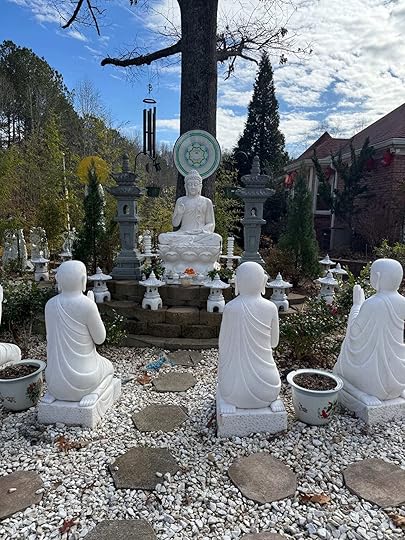 Buddha Statue and seated disciples, Truc Lam Bao Chi Buddhist Temple, Lawrenceville, Georgia photo courtesy the author
Buddha Statue and seated disciples, Truc Lam Bao Chi Buddhist Temple, Lawrenceville, Georgia photo courtesy the authorSpotting
In doing turns in dance, the key to focusing, that is, not getting dizzy, is to spot something on the wall, like a picture or a light switch, anything that isn’t moving, and is at eye level. Spotting is keeping my focus as I’m turning, and then snapping my head around at the last minute to continue to see the same spot. Done well, the turn is generally beautiful and the dancer can make multiple turns in one continuous spin. Go ahead and try it. Stand up, find something at eye level that you can focus on. Then, turn your body by making small steps with your feet in a clockwise direction but don’t move or tilt your head. Focus on something on a wall or something that’s stationary at eye level out your window or whatever. When you can’t leave your head in that position as your feet turn the rest of your body, quickly turn your head and find the spot you were focused on, as your feet bring the rest of your body 360 degrees. (Here’s a short video demo of spotting from YouTube.)
Note that it’s only the mind that gets dizzy when we’re not spotting during a turn!
Like spotting in a turn, focused on the same place on a wall or what have you, I can focus on the fact that all beings have Buddha Nature no matter how they appear to me, or what’s going on in the visible or invisible worlds. That is, we’re doing our best, but we forget the massive jewel of Buddha Nature, and the opportunity to realize it, that we possess in this life. The great opportunity to be free. I think my focus is to remember that, and to help others remember that.
So, when I can remember to, and I’ll admit in the midst of a turn, it’s easy to forget, I spot Buddha Nature, focus on it, with turns in impermanence that constantly arise.
Zazen and Focus
Focusing on Buddha Nature as much as possible allows me to be helpful to others, as well as feel everyone’s depths of the grief of their suffering, real or imagined. This focus comes with Zazen, or Zen meditation, where I am encouraged to forget myself, understand who I really am, remember the focus, and be of help to all beings.
Naturally subject to ignorance and grasping for “out there,” that is, not realizing or knowing Buddha Nature, or duality, that is, always comparing good and bad, right and wrong, life and death, and the suffering that arises from them, at some point I finally remember. Keep my eye on Buddha Nature as I turn. As the space “out there” seems to turn me. How to do that? Let everything arise as it does. Realize my small mind is conditioned, dizzy, and what I see isn’t a total view of anything, but that my Buddha Nature is always there, stable in emptiness. It’s able to see things clearly as they are. The Buddha Nature “spot” is what I can focus on, and return to. Knowing that I can’t escape my life, that the gift of life is essentially the way to realize Buddhahood, and myriad things–disappointments, happiness, grief, sadness, change–arise to help me remember. What I see externally is not what might actually be there, I’m seeing with a lens or two, a filter, a learned identity. I’m deluded though I’m maybe not aware of it, I’m also free, dancing three natures in the dependently arising world.
And then, I let that go too.
Carla Stalling Walter’s soon to be released Dance Meditation and Zen for the Black Cancer Patient can be preordered. Please visit her website for more information.
Share Dance and Zen Meditation
1For more information on the three natures, please check out Making Sense of Mind Only: Why Yogacara Buddhism Matters November 7, 2023 by William S. Waldron.



